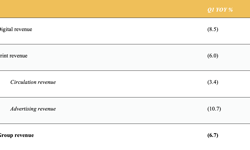It’s no longer good enough to measure the success of your website based on the number of visitors you are getting and the number of pages they are looking at, versus the sales you are generating.
Standard analytics give us information on where visitors originate from, whether it’s their first time on the site and at what point they exit the site, but they don’t tell you why they are not staying or purchasing from us.
97% (Coremetrics study, August 2008) of new visitors to UK retail sites leave without purchasing anything; now that’s a scarily high number. Understanding our customers’ behaviour is key to the success of the site.
With the importance of having an online presence, we have all been quickly trained in how to increase traffic and get customers to our sites but how many of us are focusing on what they are doing when they get there. This is the key to increasing subscription conversions and consequently revenues.
Adapting your website is the most obvious place to start, but how do you know what to change to make that difference?
There are some questions we need to ask to establish this:
* Is the landing page relevant? I’m sure we’ve all clicked on a sponsored link only to be taken to a general homepage, not the product we were looking for. The lesson here is that it’s important to tailor this to your search activity.
* Are we engaging with our customers? Once arriving at the site, are we giving them a reason to buy the subscription, guiding them through the benefits and convincing them it’s a good idea to also buy one for their friend.
* Is the site easy to navigate? Common sense, keep it simple; think about it from their perspective – is it easy to check basket content and then continue shopping?
* How do we keep them clicking? Getting them to view multiple pages can increase your chance of selling more than one subscription. Including reasons to buy more x-sell purchase can aid this.
Understanding your customers
Building a picture of the users’ journey from their point of view will help you answer the above. One of the best ways to do this is through multivariant testing – you are able to have thousands of variations to your page to allow you to optimise it and increase sales in real time. But you don’t need to employ a team of analysts working round the clock; thankfully there are varying levels of software to do the job for you. Google provide a version free of charge, or to be guided through the process with advice along the way you can use consultancies such as Optimost.
At IPC, we chose Optimost to test our existing central subscriptions site to give us insight for the development of our new site and because of their experience with other publishers.
Decide on your tests
So, first things first - what do you want to test? There are a few options:
* By traffic source. Test depending on which marketing channels your visitors are arriving from.
* Timing. Whether it’s specific times in the day or at certain times of the week.
* Customer profile. Are there visitors who are repeat customers and do they require different messages to first time visitors?
Finally, be clear on what you want to test, is it the entire site or just that final confirmation click to purchase page.
Our primary objective was to increase sales conversions through analysing and refining our existing order process. We have seven stages, which in modern day sales seems crazy - it’s like having to go to three different tills in a shop, one to get the tags removed, one to pay the money and another to put the product in a bag.
We knew we could get the customers onto the site (we’d had the training) but we wanted to ensure they could buy easily and we wanted to know what was influencing those decisions.
So we started at our individual magazine product pages and followed it through to completion of order. You really can test anything from the colour of the text to whether it’s right or left aligned. The beauty is it’s automated and the software will pull out the winning combinations of a page and start testing together so you don’t have to go through pages of results and try and make sense of it. Make sure you allow a decent amount of time for testing – we started with three months but ended up going for six.
Small changes, big impact
What we discovered was that minor changes, which are barely noticeable, can have a massive impact, up to 20% improvement in the click rate. Something as simple as the size of the magazine title on the product page or whether the checkout button is green or red. All of this was also influenced by timing and especially seasonality – we tested over the Christmas period where, as you’d expect, behaviour of our customers varied before and after. It all makes complete sense, but seeing it in black and white means you can really think about tailoring your pages for certain times of the year.
Not all visitors are equal and not all users have the same purpose, so tailor your content and page structure to the channel and user expectation. Visitors may be coming from search engines, browsing, or specifically looking for it, so understanding where your visitors are coming from (eg from an email or banner ads) will help this.
Look at your site as a whole, not in isolation. Consider all the elements from the initial landing page to the delivery confirmation details. Take all the segments of analysis you have found and apply them to improving the customer journey through the entire site.
Increase tracking mechanisms so you are able to continue to analyse. Adding tracking code to banner ads gives you more detail on impressions versus conversions.
Continue testing – always look at what you want to test, understand it, implement the changes and start all over again. So many variations were tested and you can never have enough information to keep digging deeper into customer behaviour. This will continue to change and evolve as the digital landscape changes. There’s no time to stand still and we feel like we have only scratched the surface.
Make it relevant - where a customer lands is key to your optimisation. These pages are their first and sometimes last impression of your site. Having used all that effort and got them there, you don’t want to then lose them at the first hurdle.
Four key tips for improving conversion
Think of yourself as the customer and apply the following rules:
1. Make sure the page you land on matches the marketing message you’ve used to get there. If you’re promoting a free gift, feature it on that page.
2. Highlight the key features and benefits of the magazine and additional extras you may get with the subscription - supplements or exclusive subscriber discounts.
3. Are you offering the best price on your site or will they find a better one somewhere else? If it’s a great price, really highlight that throughout the order process.
4. Make it easy to place that order and complete the final stage of conversion.
The checkout
That final stage really is crucial. Having got over the first hurdle you now want them to go through the order process to actual purchase.
So think about the following:
* How many stages do you have to your order process? We realised that seven stages was far too many – reducing that should improve conversions.
* Do you include an indicator of stages of ordering, so your customer knows how they are going to complete their order and how long this might take them?
* Is it clear what they have to click on to get to the next stage and what word do you use to get them there, ‘continue’ or ‘next’? This is another small but potentially impactful test.
* Feedback. You don’t want to lose a customer because they are having difficulty with the site – this also gives you the opportunity to collect some info on what problems they are having and how they are using the site. You can do this either when they abandon their shopping or on completion – any feedback is going to be useful at both stages to learn more about your customers’ buying habits.
I’m sure all of this seems very straightforward, and it is. In direct marketing, we are constantly testing our offline channels from the headline on an advert to the letter creative in a direct mail pack. But this practice is not commonly employed in the online space and should be inherent to all the principles we work by. We use these to learn and guide us in how to communicate with our customers and how best to engage them and consequently get them to purchase our products. So, if we are able to do this testing in an offline capacity, there’s no reason why we shouldn’t also do it online, as we know the impact can be very effective.
You’ll be amazed at what you can discover through this type of testing. Improving optimisation on your site really is the key for future success. With so much choice available to the consumer, it is becoming ever more important to lock them in from that first moment of contact. So, understanding and then delivering what your customers want and creating a personal experience will really help to push your business forward.










